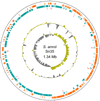Genomic sequence analysis and characterization of Sneathia amnii sp. nov
- PMID: 23281612
- PMCID: PMC3535699
- DOI: 10.1186/1471-2164-13-S8-S4
Genomic sequence analysis and characterization of Sneathia amnii sp. nov
Abstract
Background: Bacteria of the genus Sneathia are emerging as potential pathogens of the female reproductive tract. Species of Sneathia, which were formerly grouped with Leptotrichia, can be part of the normal microbiota of the genitourinary tracts of men and women, but they are also associated with a variety of clinical conditions including bacterial vaginosis, preeclampsia, preterm labor, spontaneous abortion, post-partum bacteremia and other invasive infections. Sneathia species also exhibit a significant correlation with sexually transmitted diseases and cervical cancer. Because Sneathia species are fastidious and rarely cultured successfully in vitro; and the genomes of members of the genus had until now not been characterized, very little is known about the physiology or the virulence of these organisms.
Results: Here, we describe a novel species, Sneathia amnii sp. nov, which closely resembles bacteria previously designated "Leptotrichia amnionii". As part of the Vaginal Human Microbiome Project at VCU, a vaginal isolate of S. amnii sp. nov. was identified, successfully cultured and bacteriologically cloned. The biochemical characteristics and virulence properties of the organism were examined in vitro, and the genome of the organism was sequenced, annotated and analyzed. The analysis revealed a reduced circular genome of ~1.34 Mbp, containing ~1,282 protein-coding genes. Metabolic reconstruction of the bacterium reflected its biochemical phenotype, and several genes potentially associated with pathogenicity were identified.
Conclusions: Bacteria with complex growth requirements frequently remain poorly characterized and, as a consequence, their roles in health and disease are unclear. Elucidation of the physiology and identification of genes putatively involved in the metabolism and virulence of S. amnii may lead to a better understanding of the role of this potential pathogen in bacterial vaginosis, preterm birth, and other issues associated with vaginal and reproductive health.
Figures






References
-
- Collins MD, Hoyles L, Tornqvist E, von Essen R, Falsen E. Characterization of some strains from human clinical sources which resemble "Leptotrichia sanguinegens": description of Sneathia sanguinegens sp. nov., gen. nov. Syst Appl Microbiol. 2001;24(3):358–361. doi: 10.1078/0723-2020-00047. - DOI - PubMed
-
- Eribe ER, Paster BJ, Caugant DA, Dewhirst FE, Stromberg VK, Lacy GH, Olsen I. Genetic diversity of Leptotrichia and description of Leptotrichia goodfellowii sp. nov., Leptotrichia hofstadii sp. nov., Leptotrichia shahii sp. nov. and Leptotrichia wadei sp. nov. Int J Syst Evol Microbiol. 2004;54(Pt 2):583–592. - PubMed
Publication types
MeSH terms
Substances
Grants and funding
LinkOut - more resources
Full Text Sources
Other Literature Sources
Molecular Biology Databases
Research Materials
Miscellaneous

